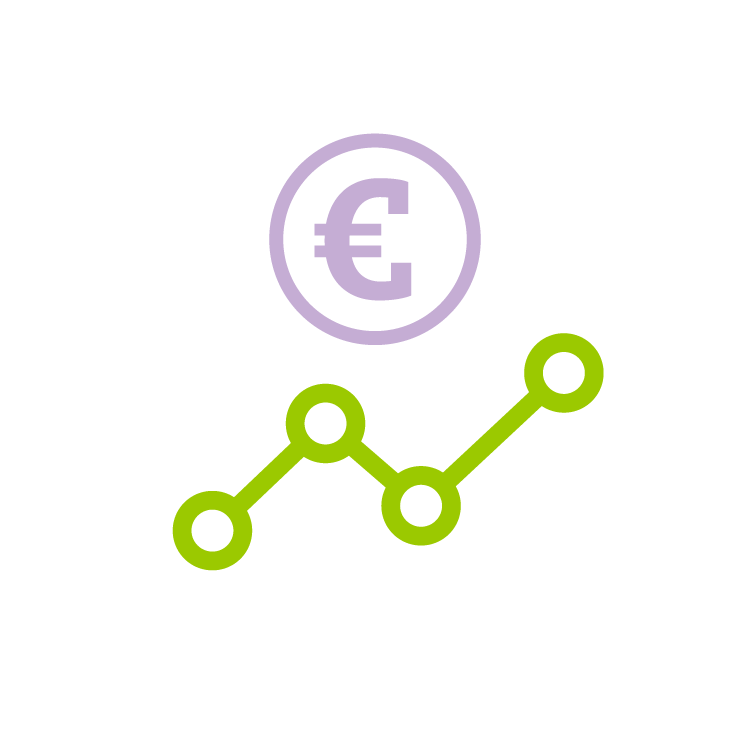Receiving variable pension in short:
- You will also receive a monthly pension under the NexT Pension. Exactly how much pension you will receive from your personal pension capital after retirement is not fixed in advance. This depends on the amount of your pension capital on your retirement date and and the interest rate at that time.
- Do you receive a pension? Then we will adjust the amount of your pension once a year, just like now.
- The way in which we adjust your pension differs from the current pension scheme. Whether your pension will go up or down will depend directly on the investment result in the previous year and the development of interest rates. It doesn't matter how high wage and price inflation has been.
- If you receive a pension, we try to prevent decreases in the pension as much as possible. We do this as follows:
- We spread investment results over a period of three years. For example, you will not see a positive or negative investment result directly reflected in your pension, but spread over three years. This ensures a more stable pension.
- We form a 'solidarity reserve'. This is used to prevent/limit cuts in your pension in case of negative (investment) results.

Video: in the new pension act: will my pension change every month?
No, your pension will not change every month. Your pension will be adjusted once a year. What will change every month is your personal pension capital. Anita Joosten, Director of Investments, explains more about how this works in this video.
Video: can my personal pension capital run out?
A frequently asked question from our members. We can be clear about this: no, you will still receive a pension for as long as you live and do not have to worry that there is no money left for your pension. Mike Pernot, Director of Pensions, explains more about how this works in this video.

Frequently asked questions about variable pension
Questions and answers
That is correct. Under the new system, you will have a personal pension capital that is invested. The value of your pension capital will fluctuate over time. You will be able to see how much pension capital you have at a particular moment. You will also be able to see what developments have affected it, either increasing its value (contributions and investment gains, for example) or decreasing its value (such as benefits that you have drawn or investment losses).
How much pension you can draw from your pension capital after you retire will not be predetermined: instead, it will depend on factors such as future investment yields and the interest rates when you retire. Those yields will depend on your age: while you are young, more of your pension capital will be invested in equities (shares) and its value will fluctuate more strongly than when you are older and it is invested more conservatively.
When the new system is introduced, your pension will also be affected more strongly by economic fluctuations: it will be more likely to go up in times of prosperity, but also more likely to go down when the economy is struggling. We will try to prevent a decrease in pension benefits as much as possible.
With regard to the increase in your pension: in the current pension system, this is always done through indexation. In new pension system your pension will not be indexed in the way that it is now. Whether your pension goes up depends on the amount of your personal pension assets. And also besides the investment return, the projection return will be determining the yearly adjustment of the benefit. More information about the projection return can be found on our Question and Answers page under the question: 'Is the calculation interest rate in the new pension system no longer important at all?'.
That is correct. Under the new system, you will have a personal pension capital that is invested. The value of your pension capital will fluctuate over time. You will be able to see how much pension capital you have at a particular moment. You will also be able to see what developments have affected it, either increasing its value (contributions and investment gains, for example) or decreasing its value (such as benefits that you have drawn or investment losses).
How much pension you can draw from your pension capital after you retire will not be predetermined: instead, it will depend on factors such as future investment yields and the interest rates when you retire. Those yields will depend on your age: while you are young, more of your pension capital will be invested in equities (shares) and its value will fluctuate more strongly than when you are older and it is invested more conservatively.
When the new system is introduced, your pension will also be affected more strongly by economic fluctuations: it will be more likely to go up in times of prosperity, but also more likely to go down when the economy is struggling. We will try to prevent a decrease in pension benefits as much as possible.
With regard to the increase in your pension: in the current pension system, this is always done through indexation. In new pension system your pension will not be indexed in the way that it is now. Whether your pension goes up depends on the amount of your personal pension assets. And also besides the investment return, the projection return will be determining the yearly adjustment of the benefit. More information about the projection return can be found on our Question and Answers page under the question: 'Is the calculation interest rate in the new pension system no longer important at all?'.
Philips Pensioenfonds is in good financial health with a current funding ratio of approximately 122% (as of October 2024). If we assume that the funding ratio will not fall by more than 2 percentage points until the moment of transition to the new pension scheme and we decide to implement the agreements in the transition plan, we can calculate what the agreements in the transition plan are expected to mean for your future pension.
Essentially, that impact is as follows:
- Immediately after we make the switch, every member will have a higher pension than under the existing pension plan.
- All our members are also expected to have a higher pension than under the existing pension plan over the entire period that they draw their pension.
- The so-called solidarity reserve provides pensions that are already being drawn with a high degree of protection against cuts. Pensions that have previously gone up are also strongly protected against cuts. The protection means that it will be less likely than under the existing pension plan that we have to lower the pensions that are being drawn.
- Measured over the long term, the pensions are expected to go up by an average of 2% per year. This means that the pensions are expected to retain at least most of their purchasing power.
This sounds very encouraging. Are there any risks?
Yes, of course this comes with some risks. Developments on the interest and stock markets are unpredictable, and investment yields could fall short of expectations. Inflation could be higher than we currently foresee, which would erode the pensions’ purchasing power over time. These risks already exist under the pension plan that we have now. Under the existing pension plan, the Pension Fund is required to maintain a buffer, which offers members protection in case the investment returns fall short. So how does this work under the new pension plan?
Risks for pension beneficiaries
In the new pension plan, pension beneficiaries of Philips Pensioenfonds are protected against shortfalls in investment returns by the solidarity reserve. At the time of switching to the new pension plan, that reserve will be filled using the Pension Fund’s buffer. Later, it will be topped up by withholding small amounts from the positive investment yields of the pension beneficiaries and other members aged 55 and up. The solidarity reserve will be used to top up your pension if it would otherwise need to be lowered. However, this is possible only if the solidarity reserve contains enough assets.
Risks for active members and non-contributory policyholders
The solidarity reserve does not protect active members and non-contributory policyholders before they start drawing their pension. The new pension plan will not include a financial buffer, meaning that negative investment returns will have a direct negative impact on the personal pension capital of those members, and on their expected pension. At the same time, however, positive investment returns will cause a direct increase in their expected pension. Under the existing system, positive investment yields are generally only used to increase the buffer, and so improve the funding ratio. A member’s pension (actual or expected) only goes up if the Pension Fund can award indexation (including compensatory indexation) on the pensions.
The transition plan of the social partners includes a pension ambition. This ambition is: at least 70% of the average indexed pension base at the retirement age, with a probability of at least 50%. This target applies to a 25-year-old who accrues a pension in the new pension scheme for his entire working life. This means that the pension is expected to be reasonably comparable on average to that in the current pension scheme.
If you want to take out a mortgage, your financial adviser will ask for data about your current and future income. Your pension information shows not only what your personal pension capital is, but also what your future income will be in a variety of scenarios. Your financial adviser will examine that information and use it to advise you on what mortgage product is the best match for your situation and how much you can borrow.
In the new pension plan, pension beneficiaries of Philips Pensioenfonds are protected against shortfalls in investment returns by the solidarity reserve. At the time of switching to the new pension plan, that reserve will be filled using the Pension Fund’s buffer. Later, it will be topped up by withholding small amounts from the positive investment yields of the pension beneficiaries and other members aged 55 and up. The solidarity reserve will be used to top up your pension if it would otherwise need to be lowered. However, this is possible only if the solidarity reserve contains enough assets. However, any amount from the pension fund’s assets that is put into the reserve cannot be used for the personal pension savings of members.
In the new system, the investment risk lies with the participant. This is in fact already the case in the current scheme of Philips Pensioenfonds. However, in the new system you will see the investment results more directly in your pension pot or in the amount of your benefit. Your pension will move more directly with the economy. This gives you the chance of a higher pension (if investment returns are positive), but you also run the risk of a lower pension (in the event of disappointing investment returns). Your pension will therefore become less certain. Moreover, the pension beneficiaries at Philips Pensioenfonds are protected against disappointing (investment) results by the solidarity reserve. At the time of switching to the new pension plan, that reserve will be filled using the Pension Fund’s buffer. Later, it will be topped up by withholding small amounts from the positive investment yields of the pension beneficiaries and other members aged 55 and up. The solidarity reserve will be used to top up your pension if it would otherwise need to be lowered. However, this is possible only if the solidarity reserve contains enough assets. The stability of the benefits is also increased by spreading the financial results (both positive and negative) over a number of years.
No, you will receive a pension as long as you live. You don't have to worry about running out of money for your pension.
On the retirement date, the annual pension is determined partly on the basis of life expectancy. This concerns the annual pension that a participant receives from his or her own pension capital. You might then expect the pension capital to have run out as soon as a participant has reached that life expectancy. If a participant becomes older than expected, this participant would no longer receive a pension from that moment on. That is of course not the intention.
The Future Pensions Act stipulates that this so-called longevity risk must be covered. This way there is also pension income if one grows older than expected. The remaining pension capitalof participants who die earlier than expected are distributed among the participants who live longer than expected. The supplementation of the pension capital as you become older therefore takes place annually and gradually and not only from the moment you have become older than expected.
This does not mean, however, that a participant does not run any longevity risk at all. If fewer participants die than expected, less pension capital will be available than necessary to supplement the pension capital of participants who live longer. This effect is relatively limited in our Fund, because the number of participants who die each year is fairly stable due to our size. Finally, if not fewer, but more participants die than expected, more pension capital will be available to supplement the pension capital of participants who live longer.
In general, it makes no difference whether you retire (early) just before or just after the transition. Since the social partners (your employer and trade unions) have requested the Fund to make use of the option of transferring in, the new pension rules will also apply to the pension already accrued and the pension that already started before the transition to the new pension scheme.
Retiring early does mean that you are no longer entitled to the compensation scheme. The following applies to this: the abolition of the average system only applies to future pension accrual. If you leave employment or retire before the transition, there is no future accrual and therefore no disadvantage for our Pension Fund from the abolition of the average system. In that case, there is also no right to compensation. As a participant, you are wise to take the compensation into account when deciding on your retirement age or date of retirement. You will only receive the compensation if you are accruing pension with Philips Pension Fund at the time of transition. This also applies if your pension accrual with us is continued due to disability.
Related information
The information below might also be interesting for you

Personal pension capital
Under the NexT Pension, you will have a personal pension capital, consisting of premiums contributed by you and your employer and investment returns.
Read more
Investing personal pension capital
We invest the pension capital for you, together with the pension capital of other members. In our investment policy, we take into account the ages of our members.
Read more